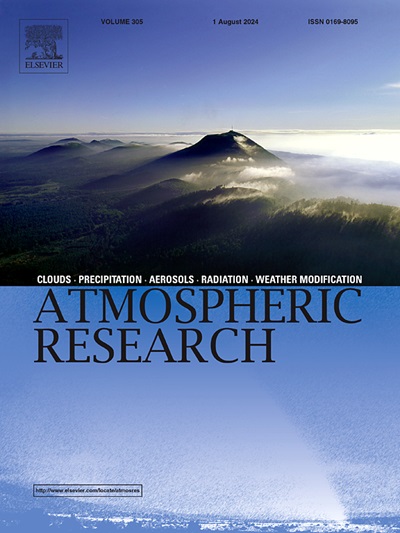第19届亚运会期间影响杭州大气能见度的主要因素
IF 4.4
2区 地球科学
Q1 METEOROLOGY & ATMOSPHERIC SCIENCES
引用次数: 0
摘要
确定影响大气能见度的关键因素是有效防治大气污染的关键。然而,能见度及其影响因素之间复杂的非线性关系给能见度研究带来了重大挑战。目前的大多数研究都依赖于经验模型进行统计分析,这可能会带来显著的不准确性。本研究将传统的改进分析方法与机器学习模型相结合,探讨了第19届杭州亚运会期间大气能见度的驱动因素和低能见度事件的成因。结果表明,在PM2.5化学成分中,SO42−、NO3−、有机气溶胶(OA)和黑碳(BC)是主要的消光因子。次生地层作用占消光系数的57%,相对湿度和车辆共同占消光系数的30%。在低能见度(10 km)时期,次生硝酸盐和相对湿度对消光系数的贡献显著增加,表明次生硝酸盐的吸湿性增长是这些事件的主要驱动因素。研究结果表明,机器学习模型在低能见度期间与改进方法密切匹配。此外,机器学习模型在捕捉强迫因素和可见性之间复杂的非线性关系方面优于改进方法。要有效治理二次硝酸盐污染,在改善整体空气质量的同时,减少氮氧化物(NOx)和氨(NH3)的排放至关重要。这种综合分析方法为提高城市大气能见度提供了科学依据。本文章由计算机程序翻译,如有差异,请以英文原文为准。
Key factors affecting atmospheric visibility during the 19th Asian Games in Hangzhou
Identifying the key factors that influence atmospheric visibility is critical for effective air pollution prevention and control. However, the complex nonlinear relationships between visibility and its influencing factors pose significant challenges. Most current studies rely on empirical models for statistical analysis, which can introduce significant inaccuracies.
This study integrates the traditional IMPROVE analysis method with machine learning models to investigate the driving factors of atmospheric visibility and the causes of low visibility events during the 19th Asian Games in Hangzhou. The results indicate that SO42−, NO3−, organic aerosols (OA), and black carbon (BC) are the primary light extinction contributors among PM2.5 chemical components. Secondary formation processes were the dominant factor that accounted for 57 % of extinction coefficient, relative humidity and vehicles together contributed 30 % of extinction coefficient. During periods of low visibility (<10 km), the contributions of secondary nitrates and relative humidity content to extinction coefficient increased significantly, suggesting that hygroscopic growth of secondary nitrates was the primary driver of such events.
The results of the study show that machine learning models closely match the IMPROVE approach during periods of low visibility. In addition, machine learning models outperform the IMPROVE method in their ability to capture the complex non-linear relationships between forcing factors and visibility. To effectively manage secondary nitrate pollution, it is critical to reduce emissions of nitrogen oxides (NOx) and ammonia (NH3) while improving overall air quality. This comprehensive analytical approach provides scientific evidence for improving urban atmospheric visibility.
求助全文
通过发布文献求助,成功后即可免费获取论文全文。
去求助
来源期刊

Atmospheric Research
地学-气象与大气科学
CiteScore
9.40
自引率
10.90%
发文量
460
审稿时长
47 days
期刊介绍:
The journal publishes scientific papers (research papers, review articles, letters and notes) dealing with the part of the atmosphere where meteorological events occur. Attention is given to all processes extending from the earth surface to the tropopause, but special emphasis continues to be devoted to the physics of clouds, mesoscale meteorology and air pollution, i.e. atmospheric aerosols; microphysical processes; cloud dynamics and thermodynamics; numerical simulation, climatology, climate change and weather modification.
 求助内容:
求助内容: 应助结果提醒方式:
应助结果提醒方式:


